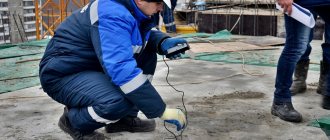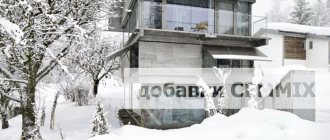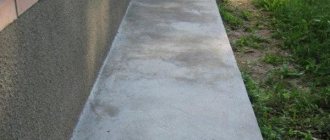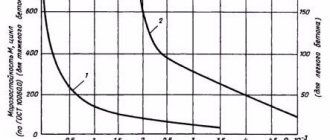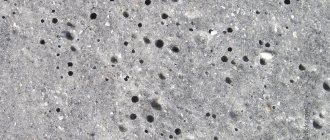- 1 Class definitions
- 2 Brand definition
- 3 Designation
- 4 Difference between classes and brands
- 5 Concrete strength class
- 6 Classification by brand
- 7 In terms of strength
- 8 Frost resistance
- 9 Waterproof
- 10 Recommendations for selection
- 11 Conclusion
When choosing a concrete mixture, everyone is faced with the question of which types are best suited for use in a particular project. Each has individual properties and areas of use. Actually, they are intended to designate concrete mixtures according to unique properties, these are the main quality indicators related to strength. In order to navigate the classes and grades of material, there are tables describing all the parameters of a particular type.
Class Definitions
The strength of the mixture depends on the correctly selected ratio of components; other factors have an influence. These include the quality of water, sand, minor changes in technology during the preparation process, hardening features, and installation conditions. This is why similar markings may not have the same strength.
The level of strength, taking into account the listed factors, is called class. This is a parameter that means the permissible value of possible deterioration in quality, provided that the strength is equal to the specified one. The class is indicated in the construction design documents. It is important to correctly correlate the characteristics - there are special tables for this.
Return to contents
Brand Definition
Identifying a brand by a wet spot.
The grade mainly depends on the amount of cement in the concrete mixture. Concrete with a higher number is more difficult to use - the higher the value, the shorter the hardening period. When choosing, it is important to choose the right quality-price match. The strength can be checked in laboratory conditions using a non-destructive method - it involves compressing the samples with a strong press.
The main criterion according to which the required brand is determined is the type of proposed structure. For preparatory work when pouring the foundation and road work, M-100, M-150 are used. The most famous is the M-200, the scope of which is quite wide - the construction of stairs, supporting walls, pouring the foundation.
For pouring monolithic foundations, M-350 is mainly used - such concrete can withstand significant loads. M-250, M-300 are gradually leaving the building materials market, they are intermediate, and are used quite rarely. Higher grades of concrete are used for the construction of hydraulic structures, dams, dams - in other words, structures subject to constant high pressure, for which special requirements are put forward.
Return to contents
Composition and proportions
The composition of B15 concrete is strictly regulated. The proportions of cement-crushed stone-sand-water for B15 have the following parameters: for cement M400 - 1: 2.8: 4.8: 0.5; for M500 - 1: 3.5: 5.6: 0.5.
You can get a high-quality mixture if you use the method of selecting the composition. For this purpose, a map is drawn up for the selection of concrete components for class B15 (15 MPa), with a cone slump of 40 mm using Portland cement M400, sifted sand, from which all foreign particles have been removed, with a density of 2600 kg/m³, granite crushed stone - aggregate size 20 mm and bulk density 1400 kg/m³. Using a special formula (obtained experimentally), the water-cement ratio is calculated. Then, according to certain schedules, water consumption is determined. The gravel size is determined using a set of sieves with holes with diameters of 70, 40, 20, 10 and 5 mm.
For beams with a width of 20 cm, gravel of no more than 5 cm is allowed. For a monolithic foundation, gravel with a diameter of up to 15 cm. Sand and crushed stone fractions are standardized by GOSTs.
An example of selecting the composition of fine-grained concrete in parts by mass:
Concrete class B15 (M200) is used for various structural elements, both in pure form and as part of reinforced concrete elements, if there are no restrictions in the project. Due to its properties and price, it is most used in the construction industry.
Designation
The classes are designated by the Latin letter “B”; the number next to it shows the load in megapascals that the concrete will withstand in 95% of cases. The full range of classes is in the range of 3.5 – 80 MPa. The grades are designated by the letter “M”, the number shows how much cement is in the finished concrete mixture. The brand designation deciphers the strength limit, which is measured in kgf/cm2.
High strength is the main determinant of quality, so the higher the value, the more expensive the mixture.
Return to contents
Monolith marking
The main performance characteristic of concrete mixtures is strength. When choosing a material, they are guided by it. In documents and on packaging, strength indicators are indicated in two ways: in the form of a brand or class. They should not be confused; these are two completely different indicators. Let's find out what each of them means.
Class
The class characterizes the actual strength of the monolith. It depends not only on the composition, but also on the conditions of its hardening. Thus, a concrete mixture that hardens without vibration or in the cold will show a lower class than planned during testing.
Denoted by the letter B and a number. It shows the pressure in MPa that the monolith can withstand. To determine the class, a fully hardened and strengthened concrete cube with a side of 150 mm is destroyed with a special press. Knowing the class, you can accurately determine the permissible load for the structure. The range of strength characteristics of materials is quite large: from 5 to 60 MPa.
- Foundation
How to properly reinforce a strip foundation with your own hands
Brand
Shows the calculated strength of the hardened “mature” material. Denoted by the letter M and a number. The number shows the level of compression that the monolith can withstand without destruction. Measured in kg per square meter. see. The calculation is based on the composition of the solution, in particular, on the amount and type of cement. The numerical indicator included in the labeling can vary from 50 to 1000.
Brand and class are correlated. It must be understood that if the monolith manufacturing technology is violated, the calculated and actual indicators may not coincide. The grade of material produced on a construction site is usually lower than planned.
In addition to these most important indicators, other designations are also used in labeling. They characterize frost resistance (F), water resistance (W) and ductility (P).
Difference between classes and brands
At first glance, the same determination criterion is applied to the brand and class, but there are significant differences between them. The first shows the average technical properties of the material, the second determines the level of strength of the material during operation. In fact, the marking indicates how much cement is present in a given mixture, while the class number shows what maximum load the structure will withstand in 90-95% of cases. These parameters are interdependent, their correspondence can be determined using a special table.
Return to contents
Composition of concrete M100
Like other brands of heavy concrete, M100 consists of: granite or crushed gravel (filler), quarry or river sand, Portland cement CEM I 32.5N PC (M400) or CEM I 42.5N PC (M500) and clean fresh water. Due to the limited scope of application, additives are not added to this brand of concrete.
For lightly loaded structures (blind area, garden path, preparatory work) erected on private farmsteads, it is allowed to use slag formed by burning coal, broken bricks and other construction waste as filler.
Concrete strength class
Testing the compressive strength of concrete and compliance with the required grade.
First of all, it determines the compressive strength. The indicator guarantees that during operation the material will withstand a certain load, which is indicated next to the letter “B” in megapascals with a possible error of 13.5% (coefficient of variation). The following factors influence strength:
- Amount of cement - the more cement contained in the mixture, the faster it hardens and the stronger it becomes.
- Water-cement ratio - a large amount of water leads to the formation of pores, which significantly reduces strength.
- Cement activity – reliable structures are made from high strength cement.
- The degree of compaction of the concrete mixture - the correct mixing technology, the use of vibration pulses and the turbo mixing method significantly increase the strength of the finished concrete.
- Quality of aggregates - the addition of impurities (clay, fine-grained additives) leads to a decrease in the strength of the composition.
Return to contents
Features and Application
Concrete class B15 is classified as structural. It is used to make load-bearing frames of buildings (slabs, panels, columns) that do not perform heat-protective functions. In terms of density, B15 is heavy. Regarding the use of binders, class B15 concrete of grade M200 is made using Portland cement M400 or M500. The composition includes, in addition to cement, crushed stone, sand and water with certain properties and in proportions selected for the brand of cement.
For concrete stairs and pouring platforms that experience temperature changes (negative and positive), B15 concrete with frost resistance F75 or F150 is used. Frost resistance F50 is determined by testing a sample to determine the ability of structures to maintain the design strength grade by 85% during 50 freezing and thawing cycles.
The foundation for a house can be made from different grades, both in terms of strength and frost resistance. The brand of mixture for the internal load-bearing walls of the foundation of a heated building may not be standardized for frost resistance. This is explained by the fact that the mixture of class B15 already has frost resistance. And the additional requirement for the number of cycles applies to designs that can receive 50 or 75 cycles during their entire service life.
Designs may have a number of special requirements. For example, in hydraulic structures, the water resistance grade should be no lower than w4. When constructing blast furnaces, heat-resistant Portland cement concrete with special additives (chromite and magnesite) is used. This mixture composition does not collapse at temperatures up to 1700°C.
Fulfilling concreting requirements consists of several stages:
- At concrete units, the future composition of grade B15 is selected as a percentage.
- Prototypes are tested in laboratories to ensure compliance with brand strength, and the data is entered into the passport.
- At the construction site, the work contractor is required to pour experimental control cubes measuring 150 x 150 x 150 mm from each batch. The samples must have the same curing conditions as the main structures.
- On the 28th day, the construction organization tests control samples, the results are recorded in the work log. The as-built documentation is presented to the customer as part of the Facility Commissioning Certificate.
- The cube strength of the samples must be converted to grade strength in accordance with the conversion table.
According to frost resistance
Destruction of concrete due to low frost resistance.
Another important parameter that directly affects the quality of the material. Particular attention is paid to it when developing projects in cold regions. Low temperatures have a detrimental effect on concrete, destroying the structure. Moisture, falling on the surface, seeps into the pores of the material, and after freezing it increases in volume. The process of constant freezing and thawing leads to the appearance of small cracks that expand over time.
Frost-resistant material is obtained using special chemical additives, which are added to the solution in the amount specified in the instructions. These materials have their own markings and exist in the range from F-50 to F-1000. The indicator next to the letter shows how many thawing-freezing cycles the material can endure without deteriorating its original properties.
Return to contents
Recommendations for selection
Visual table of concrete class and concrete grade.
First of all, the choice depends on the characteristics of the planned project, its size and weather conditions - in this case, it is worth paying attention to additional capabilities and the ability to withstand negative influences. Based on the strength value, leave a small margin; violation of the solution technology slightly reduces the indicated number.
By following these recommendations, you can simplify the problem of choosing the right material:
- For preliminary work, screeds, and pouring foundations for one-story buildings, use less durable concrete - up to M-150 inclusive.
- M-200 is one of the most frequently used, suitable for the same work, used in the construction of stairs and partitions.
- M-300 is the best option for reasons of quality-price ratio. The scope of application is very wide - floors, strip foundations, walls, fences.
- M-350 is suitable for the construction of supports, artificial reservoirs, and in the production of reinforced concrete. This material makes a very reliable foundation; it is excellent for the pile casting method.
- M-400 is indispensable for construction in problem areas, construction of buildings with basements, and construction of cellars. In industrial activities they are used for the construction of storage facilities and bridges.
Return to contents
What is concrete, its varieties
Concrete, used for construction purposes for several thousand years, is an artificial material. It is made from several components: binder, filler, water and additives that improve performance, and goes through the stages of molding and hardening.
Concrete grade and concrete class
Concrete is a universal material; its scope of use is extremely wide. It is actively used in the construction of buildings, fences, bridges, roads, other types of structures, as well as individual products necessary in construction and finishing.
The components of the mixture from which artificial stone (as it is often called) is obtained must be correctly selected so that after molding and hardening the characteristics of the material comply with current standards.
Additives to accelerate concrete hardening
Types of concrete
Today, many types of stone materials are produced, which are regulated by GOST 25192*2012, which can be used in various construction fields. Concrete is classified according to several criteria. Depending on the purpose, it can be structural or special . Natural conditions or heat treatment can be used for hardening. The material also differs in abrasion, frost resistance, and water resistance.
Structural concrete
Table. Concrete grades depending on characteristics.
| Degree | Abrasion | Frost resistance | Waterproof |
| Low | G1 | Up to F50 | Up to W4 |
| Average | G2 | F50…F300 | W4…W12 |
| High | G3 | From F300 | From W12 |
Several other types of material are classified according to a number of characteristics.
Density of concrete
Depending on the density, a distinction is made between extra-light, light, heavy and extra-heavy artificial stone. Where different varieties are used is clearly shown in the photo.
Concrete classification table
Type of binder component
The most common material is cement-based. It is often called cement concrete. Also, gypsum, lime, slag or polymers can be used as a binder.
Why are cement concrete roads better than asphalt concrete roads?
Type of filler
Dense, porous and special components are used to produce concrete. Depending on the type of aggregate, the following types of building materials are produced:
- heavy (the main components are cement, as well as dense coarse and fine filler);
- fine-grained (it uses dense fine aggregate);
- wood concrete (organics are used as filler: wood chips, rice straw, etc.);
- soil concrete (an integral part of the mixture is ground or granular soil);
- ash concrete (in lightweight concrete, ash is used as a filler);
- polymer concrete (composed of polymers and monomers), as well as some other varieties.
What is wood concrete
Structure
Based on the structure of the material, the following types can be distinguished: dense, porous, cellular and large-porous.
Macrostructure of concrete
In addition, concrete can be reinforced (reinforcing bars or mesh are placed in its body to increase strength). Fiber-reinforced concrete is also produced. In the manufacture of this material, small fibers (fiber) are used, which can be made from steel, polypropylene, cellulose, basalt, polyamide, etc. Such inclusions can significantly increase the strength characteristics of artificial stone.
Fiber concrete structure
Conclusion
Marking is an indicator of the approximate, average technical characteristics of the material, while classification guarantees compliance with the required parameters by 90-95%. The properties of the first are distinguished by three characteristics - strength, frost resistance, water resistance, which are designated by the letters M, F, W, respectively.
The choice of a specific concrete mixture depends on the characteristics of the project, the size of the proposed structure, purpose, and external conditions.
Normative documents
The production of building materials is overwhelmingly regulated by various state standards. GOST 25192-2012 defines the classification of concrete according to the main characteristics:
- Purpose;
- Resistance to various types of corrosion;
- The type of binder used, which determines the basic properties of the material;
- Structure of mortar and stone;
- Hardening conditions;
- Strength is the main parameter that is taken into account when choosing components for preparing a solution;
- Rate of strength gain;
- Density is average;
- Frost resistance;
- Waterproof;
- Abrasion resistance.
Let's consider the main features that must be taken into account when choosing concrete for construction.

